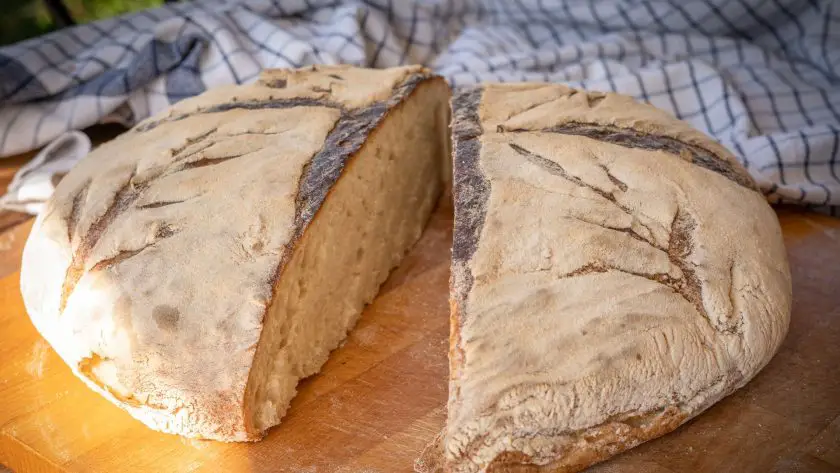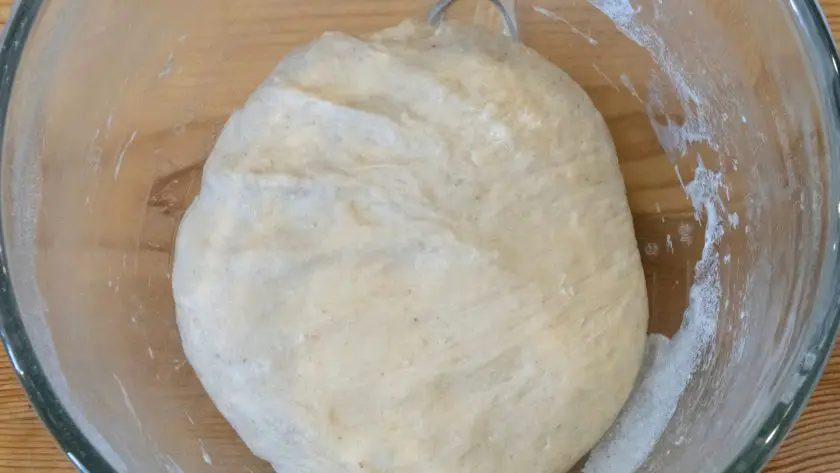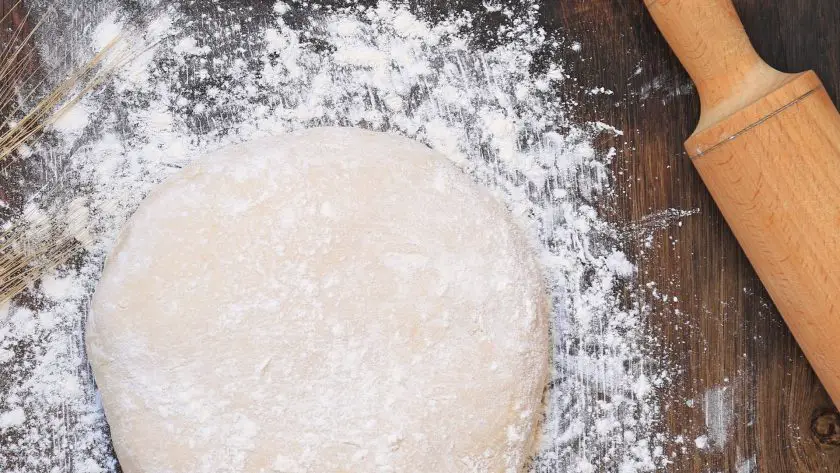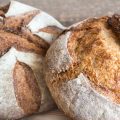Biting into a fresh sourdough loaf only to find a dense interior or misshapen crust is a disappointment for any baker. Sourdough’s complex process leaves much room for error, and struggling with preventable problems with sourdough bread can be frustrating. In this article, we tackle some of the most common pitfalls, so you can avoid sourdough mishaps. Gain the troubleshooting knowledge to rescue even mediocre loaves. Say goodbye to sourdough woes and hello to the satisfying bite of a perfect crusty loaf. Here’s the key to the consistency your bread deserves.

Table of Contents
- Inconsistent Fermentation
- Density and Texture Issues
- Crust and Crumb Problems
- Flavor Imbalances
- Mold and Preservation
- Sourdough Solutions: Fixing Common Blunders
- Common Problems With Sourdough Bread: FAQs
Inconsistent Fermentation
One of the most common issues when baking sourdough bread is inconsistent fermentation, which can lead to a dense or gummy texture in the final loaf. Proper fermentation relies on maintaining the right balance of yeast and bacteria activity, and there are a few key factors that can throw this delicate equilibrium off.
Managing Fermentation Temperature
Temperature is critical for consistent fermentation. The yeast and lactobacilli in your starter prefer a narrow temperature range around 78-82°F. If your kitchen is too cold, fermentation will slow down dramatically. On the flip side, excessive heat can kill off your yeast and bacteria. Investing in a proofing box with a heating pad is very useful for maintaining the ideal temperature. You can also try proofing your loaf in the oven with just the oven light on. Tracking fermentation times at different temperatures will help you adapt your process.
Monitoring Starter Health
An unhealthy sourdough starter means poor fermentation. Signs of a struggling starter include minimal rise after feeding, excessive hooch (liquid) on top, or unpleasant smells. Starters can become stressed by irregular feeding schedules, temperature swings, excessive chlorinated water, or depletion after frequent baking. Rebuild your starter’s yeast and bacteria by discarding most of it, then feeding 1:1 flour: water twice a day at room temperature. Returning to whole grain flour and filtered water helps too.
Allowing Proper Fermentation Time
Be patient and allow your dough adequate time to ferment and develop flavor. While tempting, cutting bulk fermentation or proofing times short produces loaves with poor oven spring and dense crumb. Watch for dough doubling in size, use the “poke test” to check proofing progress, and extend time if needed. Don’t rush your sourdough at any stage. Record fermentation durations to learn the appropriate timing for your kitchen’s conditions.
With a bit of tweaking to adapt to your individual starter and environment, you can achieve beautifully consistent fermentation. This allows you to produce loaves with an even, airy crumb and complex tangy flavors time after time. Pay close attention to your fermentation factors, and you’ll be rewarded with the perfect rise and texture in every sourdough bake.

Density and Texture Issues
One of the most frustrating issues when baking sourdough is a dense, heavy crumb or overly chewy texture. While a tender, airy interior is the goal, various factors during the bread making process can lead to a too-dense loaf. Luckily, with a few tweaks and kneading techniques, you can transform that dense sourdough into the light and fluffy loaf of your dreams.
Optimizing Hydration for Texture
Hydration, or the ratio of water to flour in your dough, significantly impacts the final texture. Most artisan sourdough recipes call for relatively high hydration levels around 75-80%. This extra water produces increased fermentation bubbles and a more open crumb. However, for beginners, such wet dough can be quite tricky to work with.
When just starting out, try lowering the hydration to around 68-72%. This produces a dough that is easier to handle and shape. You can gradually increase the hydration as you gain experience. Keep in mind that different flours absorb water differently. Whole wheat flours need more hydration, while rye requires less. Play around to find the ideal hydration sweet spot for your flour blend.
Kneading Techniques for Developing Gluten
Gluten development is key to an airy loaf. After mixing your dough, perform a series of stretch and fold maneuvers during the bulk fermentation. This aligns and connects the gluten strands. Slap and fold the dough intermittently to develop gluten strength. Perform a final kneading before the final proof for an extra boost.
Be careful not to over-knead, as this can damage the gluten networks. Knead just until the dough is smooth and passes the “windowpane test”. Finding the right kneading balance takes some experimentation based on your dough.
Consider the Flour
The type of flour significantly impacts the texture. Lower protein bread flours produce denser loaves compared to higher protein flours. Try supplementing some bread flour for a portion of the whole wheat or rye. Vital wheat gluten can also help strengthen the gluten strands for a lighter crumb.
Speaking of gluten, I delve more into the topic in my blog post: Is Sourdough Bread Gluten Free?
Allow Adequate Proofing Time
Rushing through proofing doesn’t give the yeast enough time to produce gas bubbles. This results in a dense crumb with minimal oven spring. Stick to the recommended proof times, and extend if needed based on the dough’s readiness. The proofing environment temperature also affects proofing speed.
With a few adjustments like hydration, kneading, and proofing time, you can modify a dense sourdough into a lighter, airier masterpiece. Pay attention as you work the dough and you’ll get a feel for what it needs. Don’t be afraid to experiment along the way. That’s how you’ll unlock the secrets to the perfect springy, fluffy sourdough crumb.

Crust and Crumb Problems
Achieving the ideal crust and crumb texture is an art form when baking sourdough bread. With attention to a few key details, you can transform your loaf from a pale softie into a beautifully browned boule with big beautiful air pockets.
Balancing Oven Temperature
One of the most important factors for crust and crumb development is proper oven temperature. Too low, and your bread won’t brown or set the crumb structure. Too high, and you risk burning the outside before the inside is fully baked. For most loaves, you’ll want to preheat your oven to 450-500°F. Place a baking stone or steel on the bottom rack, and pour 1 cup of water into a pan on the lowest rack. This steam helps the loaf rise and brown initially. After 20 minutes, remove the water pan and lower the temperature to 400°F to finish baking more gently.
Introducing Steam
That initial blast of steam is crucial for both crust formation and an airy crumb. The steam gelatinizes the exterior starches, allowing the crust to brown beautifully, plus it gives an extra boost of oven spring. If your oven doesn’t hold humidity well, try spraying the loaf with water before closing the oven door. You can also place a pan of ice cubes on the bottom rack below the bread. Experiment with steam techniques to find what works for your oven.
Allowing Proper Bake Time
Be patient and give your sourdough the full baking time it needs. For a large miche, this can take 45-60 minutes. Underbaking prevents the crumb from fully setting and causes gummy texture. Use an instant-read thermometer to test for doneness – the center should reach 205-210°F. If you notice pale color or soft spots, continue baking for 5-10 minute intervals until the crust browns and the loaf sounds hollow when tapped. Proper bake time is especially important for whole grain loaves.
With a bit of oven tweaking and steam tricks, you’ll achieve the crust and crumb of your dreams. Pay close attention and get to know your oven’s hot and cool spots. Make notes on what works to re-create that perfect loaf. Soon you’ll effortlessly turn out sourdough boules with crackly crust and an open, even crumb every time.
Additional Tips for Tuning Texture
Beyond temperature and steam, other factors impact the final crumb and crust such as:
- Scoring loaves properly to control expansion direction. Deeper, angled cuts provide the best oven spring.
- Allowing for adequate proofing time so dough is light and airy before baking. An underproofed loaf won’t rise sufficiently in the oven.
- Using a baking vessel like a Dutch oven to provide an initial moist, enclosed environment for maximum rise.
- Spritzing loaves with water right before loading into the oven for sheen and crispiness.
- Letting loaves cool completely before cutting for the best crumb structure. Warm loaves compress when sliced.
Flavor Imbalances
One of the trickiest aspects of sourdough baking involves properly balancing the sour flavor against the sweeter, bready notes. Going overboard in either direction results in loaves that miss the mark for balanced flavor. However, with careful control of fermentation time and flour selection, you can achieve ideal sourness and complexity of taste.
Managing Fermentation Duration
The length of fermentation directly impacts the intensity of sour flavors in the final loaf. During fermentation, yeast and bacteria produce acids that give sourdough its tang. Longer fermentation equals more acid production equals greater sourness. While you want enough sourness to provide that signature sourdough zing, excessive fermentation can push it over the edge to unpleasantly sharp territory.
As a general guideline, aim for 8-12 hours of fermentation at cool room temperature for most standard loaves. Monitor the rise and bubble activity. Let it go a bit longer if your starter is less active to allow more acid development. However, if you clearly see signs of overflowing bubbles and rapid rising before 8 hours, move the dough to the fridge to slow things down. The ideal time will vary based on factors like starter strength and ambient temperature. With controlled fermentation duration, you can reliably achieve your preferred level of sourness.
Harnessing Flour Power
The types of flour used significantly influence the flavor profile beyond just sourness. White flours ferment more rapidly, while whole grain flours contain more sugars that get converted into complex flavors. Incorporating some whole wheat or rye flour lends earthiness, while an all-white loaf tastes sweeter and less tangy.
You can blend flours to strike the right balance for your preferences. As a starting point, try 15-25% whole wheat or rye and the remainder bread flour. The heartier flours provide depth without overly slowing fermentation. If you enjoy pronounced sourness, use a higher percentage of white flour. For nuttier loaves, increase the whole grain content. You can even experiment with other ancient or alternative flours like spelt, buckwheat, or einkorn for more diversity of flavor.

Mold and Preservation
One of the most disheartening things as a sourdough baker is cutting into a beautiful loaf only to discover fuzzy spots of mold. While a certain level of sourness is desirable in sourdough, mold is one sour invader you want to avoid. Proper storage methods are key to preventing mold growth and extending your sourdough’s shelf life.
Keeping Loaves Mold-Free
With its lack of preservatives and moisture-retaining crumb, sourdough tends to mold faster than commercial breads. Warm environments accelerate mold spore growth. The key is controlling temperature and moisture to inhibit spoilage. Here are some tips:
- Allow loaves to fully cool before storage. Any residual warmth creates a breeding ground for mold.
- Wrap cooled loaves in a clean kitchen towel then place inside a paper or plastic bag. The double wrap prevents drying while still allowing ventilation.
- Store loaves at room temperature up to 3 days. After that, transfer to the fridge still wrapped.
- Use ultra-airtight containers like FoodSaver bags or quality plastic containers for extended fridge storage. Limit air exposure.
- Freeze any loaf you won’t consume within 5 days. Thaw frozen loaves in the fridge overnight before serving.
With vigilance against moisture and warmth, you can keep mold at bay and enjoy your loaves over an extended period.
Recognizing Early Signs of Spoilage
Catching mold in its early stages prevents wasting perfectly good bread. Here’s what to look for:
- Examine the sides and bottom crust closely for the onset of fuzziness or spots. Mold typically shows here first.
- Give loaves a squeeze to check for firmer or damp sections, an early red flag.
- Detect any musty odors when initially cutting into a loaf. Early mold may not yet be visible.
- Note any sliminess or dark splotches inside the crumb, potential indicators.
- If in doubt, when in doubt, throw it out. Don’t risk eating moldy bread.
By thoroughly inspecting your sourdough and being attentive to changes from the norm, you can identify problems with sourdough bread before they spread. Mold only becomes visible at the end stage, so go by smell and texture too. When you detected mold early, cut away the affected portion and enjoy the rest mold-free.
Store your sourdough properly and it will handsomely reward you with its complex flavors day after day. Just take care not to get too attached as you wave goodbye to those final stale heels. The next fragrant loaf awaits!
Sourdough Solutions: Fixing Common Blunders
Sourdough baking requires patience, precision, and persistence. But with proper temperature control, a healthy starter, gentle kneading, and the right oven steam, your loaves will rise beautifully. Monitor fermentation times to balance sourness. Blend flours for flavor complexity. And store properly to prevent mold. Stay observant, keep adjusting, and focus on fundamentals. With passion and care, you’ll be rewarded with perfect crust and crumb. So keep practicing your craft one loaf at a time. Soon, you’ll have the tastes and textures of sourdough success in every slice.
Common Problems With Sourdough Bread: FAQs
What is the disadvantage of sourdough bread?
Sourdough bread can take a long time to make since the starter needs time to ferment and develop flavor. This requires planning ahead and can be inconvenient compared to making regular yeast bread, which rises more quickly. The sour taste may also not appeal to some who prefer milder bread.
What can go wrong with sourdough bread?
If the starter is not cared for properly and fed regularly, it can lose potency resulting in poor rise and flavor. Overproofing can lead to a gummy bread interior. If the dough is handled roughly, the air bubbles can deflate. Using low quality flour can prevent the bread from rising well and developing an airy crumb. Proper technique, high quality ingredients, and patience are key for great sourdough.
Why do I feel weird after eating sourdough bread?
The long fermentation process of sourdough bread produces acids like lactic and acetic acid. For those sensitive to sourdough, these acids may cause mild stomach upset or bloating. The gluten structure can also differ in sourdough, which may affect those with gluten intolerance. As with any new food, take note of how your body reacts and reduce portion sizes if needed while adjusting to sourdough.
When should you not eat sourdough bread?
You should avoid sourdough bread if you have a gluten intolerance, yeast allergy, or sensitivity to fermented foods. The lactic acid bacteria used to make sourdough can cause digestive issues for some people. Pregnant women are also advised to limit sourdough consumption, as the bacteria may pose a slight listeria risk. Otherwise, sourdough can be enjoyed in moderation as part of a balanced diet.


![[Video] From The Seed To The Peasant Bakery With Nicolas Supiot 6 [video] from the seed to the peasant bakery with nicolas supiot](https://www.mydailysourdoughbread.com/wp-content/uploads/2022/11/image-18-120x120.jpeg)

![Is Keto Sourdough Bread Low Carb - What You Need To Know [Plus Bonus Recipe] 8 Is keto sourdough bread low carb - what you need to know [plus bonus recipe]](https://www.mydailysourdoughbread.com/wp-content/uploads/2022/09/CD-blog-images-2022-09-28T221612.311-e1665964918416-120x120.jpg)

